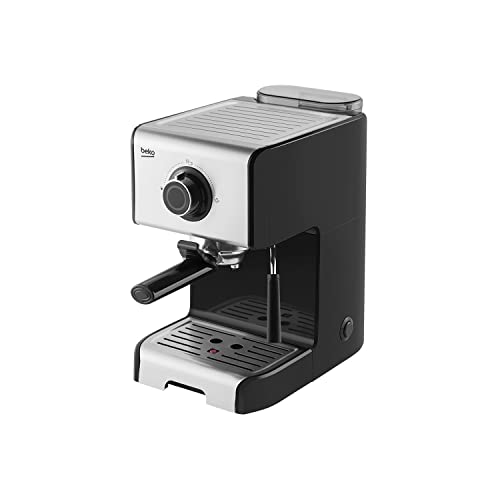Coffee and Espresso Machines
Espresso machines use pressure to force water into finely ground and tamped beans. They produce a rich, flavorful brew.
Experts at the Good Housekeeping Institute recommend models that brew with the minimum pressure of 9 bars to get the most efficient extraction. Beware of brands that claim to use more pressure than is needed.
Types
The espresso maker, also called a coffee and espresso maker, produces the highest-quality, concentrated coffee that you like in your favourite cafe drinks using an average of 9 bars of pressure. They come with a range of options, such as the control of temperature and brew strength, programmable brewing and multiple drink sizes. Some machines might have manual or automatic steam wands for creating texturized milk to create artwork with latte. They can be found in three major kinds of espresso machines, including semi-automatic, automated, and super-automatic models. Each model has its own degree of supervision and automation.
The most popular espresso machine for specialty coffee shops is the semi-automatic model. Semi-automatic espresso machines allow baristas full control of the brewing process but aren't as user-friendly as fully automatic or automated machines. To get the most perfect espresso shot, grind the beans, fill the portafilter and tamp it down, then adjust the time of extraction.
Automated machines have a built-in grinder that can measure and tamp the grounds for you. They automatically disperse the right amount of water needed to extract the espresso, and they often come with a programmable drink size function. They were the most common espresso machine in our lab tests and they provide a good combination of consistency and human control.
Functions
If you choose a pump-driven machine or a steam-driven model, you'll get an in-line reservoir that houses the water used to make your coffee. There's also an element of heating that heats up the cold water, generating the pressure necessary for extraction of coffee from grounds.
When the brew lever gets raised it triggers the water inlet cam to seal the pre-infusion valve so only hot water that has been pressurized to the maximum pressure flows through the portafilter into ground coffee. It takes around 25 seconds for the water to brew into espresso.
The insulated tubing, also known as the hot-water tubing runs from the reservoir to the spout that is on top of your machine. The heating element of resistance heats the water as it flows through the metal warming plate and the aluminum tube.
When the spout has been turned on, place your cup in the spout to capture the espresso as it flows through the portafilter into your cup. The coffee maker also comes with a steam wand that you can use to heat up and froth the milk to make espresso-based drinks like cappuccino and Latte.

Automated machines take the guesswork out of making coffee. They operate with just one button they can be programmed and grind and measure beans for you, and reduce them. In our Lab tests, they tend to be the most effective because they are user-friendly and don't require a lot of user skills.
Materials
The inside of an espresso machine is a veritable world of copper tubes, boilers made of stainless steel, and sophisticated firmware. They might appear complicated however, at the heart they do just one simple thing: force hot water through coffee that has been finely ground.
When shopping for an espresso maker, think about the size and the space needed, beverage options, energy-saving options and brewing precision. Also, look for a steam knob that will activate the steam wand, which is used for frothing milk and making Latte art. A gauge for pressure on the front of the machine tells you the boiler's and pump's operating pressure. You should search for an espresso machine with two needles in order to determine the minimum and maximum pressure.
If you're looking for more then espresso, then you should consider the machine that comes with different sizes of brew. This includes ristretto. There are models with an adjustable frothing hopper which lets you enjoy hands-free, hassle-free frothing. You can also switch between various types milk easily. If you're experiencing hard water, choose one with a built-in softener to avoid mineral build-up and keep your espresso tasting fresh.
Some manufacturers use a thermostat that is digital integral and proportional to maintain an exact temperature range while brewing espresso. This feature helps ensure the same high-quality, consistent cup of espresso each time. This feature can also help reduce cost of energy since the machine only operates when necessary.
Maintenance
Since espresso and coffee machines become more widely available for home use, proper maintenance of this equipment becomes more important. espresso coffee machines www.coffeee.uk can make an enormous difference in the quality of your coffee however only if it is properly maintained.
A regular maintenance and cleaning routine should include everything from cleaning the group head and steam wand, to descaling, to changing the water filter on a regular basis. As a general rule that you make between two and five cups of coffee each day, you should clean most parts of the machine at least once a week. Some components of the machine will need to cleaned every two to three weeks, for instance, the water tank and the grinder.
In addition, you must backflush your machine every week. This is a process that involves locking the portafilter in position and running the brew process several times. This allows you to get rid of any stray coffee grounds or oils left behind. You can also clean the portafilter using a brush and cleaner designed specifically for espresso machines.
Maintaining your espresso and coffee machine in a proper manner can ensure that it lasts longer. It is important to maintain your expensive professional espresso machine.
